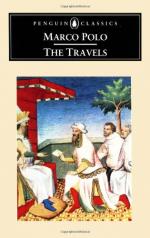[Sidenote: They pass by Persia to Venice. Their relations there.]
22. The princess, whose enjoyment of her royalty was brief, wept as she took leave of the kindly and noble Venetians. They went on to Tabriz, and after a long halt there proceeded homewards, reaching Venice, according to all the texts some time in 1295.[22]
We have related Ramusio’s interesting tradition, like a bit out of the Arabian Nights, of the reception that the Travellers met with from their relations, and of the means that they took to establish their position with those relations, and with Venetian society.[23] Of the relations, Marco the Elder had probably been long dead;[24] Maffeo the brother of our Marco was alive, and we hear also of a cousin (consanguineus) Felice Polo, and his wife Fiordelisa, without being able to fix their precise position in the family. We know also that Nicolo, who died before the end of the century, left behind him two illegitimate sons, Stefano and Zannino. It is not unlikely that these were born from some connection entered into during the long residence of the Polos in Cathay, though naturally their presence in the travelling company is not commemorated in Marco’s Prologue.[25]
[1] Zurla, I. 42, quoting a MS. entitled Petrus
Ciera S. R. E. Card, de
Origine Venetorum et de Civitate
Venetiarum. Cicogna says he could
not find this MS. as it had
been carried to England; and then breaks
into a diatribe against foreigners
who purchase and carry away such
treasures, “not to make
a serious study of them, but for mere
vain-glory ... or in order
to write books contradicting the very MSS.
that they have bought, and
with that dishonesty and untruth which are
so notorious!” (IV.
227.)
[2] Campidoglio Veneto of Cappellari (MS. in
St. Mark’s Lib.), quoting
“the Venetian Annals
of Giulio Faroldi.”
[3] The Genealogies of Marco Barbaro specify
1033 as the year of the
migration to Venice; on what
authority does not appear (MS. copy in
Museo Civico at Venice).
[4] Cappellari, u.s., and Barbaro.
In the same century we find (1125,
1195) indications of Polos
at Torcello, and of others (1160) at
Equileo, and (1179, 1206)
Lido Maggiore; in 1154 a Marco Polo of
Rialto. Contemporary
with these is a family of Polos (1139, 1183,
1193, 1201) at Chioggia (Documents
and Lists of Documents from
various Archives at Venice).
[5] See Appendix C, Nos. 4, 5, and 16. It was
supposed that an autograph
of Marco as member of the
Great Council had been discovered, but this
proves to be a mistake, as
will be explained further on (see p. 74,
note). In those days
the demarcation between Patrician and
non-Patrician at Venice, where
all classes shared in commerce, all
were (generally speaking)
of one race, and where there were neither
castles, domains, nor trains
of horsemen, formed no wide gulf. Still
it is interesting to establish
the verity of the old tradition of
Marco’s technical nobility.




